I'm a Boston artist with an ever-growing body of under-documented work, more or less addicted to the process of artmaking.
I've been lucky enough to get a few invitations to produce work elsewhere, including within artist residencies, and found these experiences very constructive. I regularly pull all-nighters applying for art opportunities, and I've made some big sacrifices—such as freelancing rather than having a traditional day-job career—to retain as much flexibility in my life as possible in order to take on new opportunities when they arise. This year I decided to try something new in an effort to see if there might be more opportunities out there than I am aware of by attending the Transcultural Exchange Conference.
Transcultural Exchange has hosted a conference for artists interested in inter-cultural dialogue biannually in Boston since 2007. However, no one I know very well has ever mentioned attending. I've been aware of the organization behind the conference but never attended the conference because I couldn't justify the $200+ ticket price since I wasn’t certain there would be a significant ROI. I also didn't know whom the conference really targeted.
This year, I decided to answer these questions for myself and for Big Red & Shiny. I know that, like me, many of Big Red & Shiny's readers are hungry for more personal exposure to and dialogue with (especially experimental) artists from around the world; for opportunities to bring their own work to places beyond the boundaries of this city and country; and are also, like me, living very non-luxurious lifestyles.
What follows are excerpts from a diary that I kept of my conference experience. My goal was to bring you along with me, sharing resources that I found useful, topics I found inspiring and noting what I felt could use improvement if the conference wants to support artists in boats similar to mine. One caveat is that I'm not very good at networking and am fairly socially awkward. So take any successes or failures at making the most of the experience—ones that hinge on suaveness and having your business card somewhere that you can access in under 30 seconds—with a grain of salt.
Except in the context of presentations or panels where speakers are identified publicly in the program guide, I use initials in place of names.
February 25, 2016
9:00am. On the B-Line, heading towards Boston University's main campus center, where this year’s conference is based. Concentrating all mental energy not needed to grip the pole on visualizing my Transcultural Exchange conference goal: acquire three direct “leads” towards international art opportunities that are appropriate to my practice, including at least one that will come to fruition.
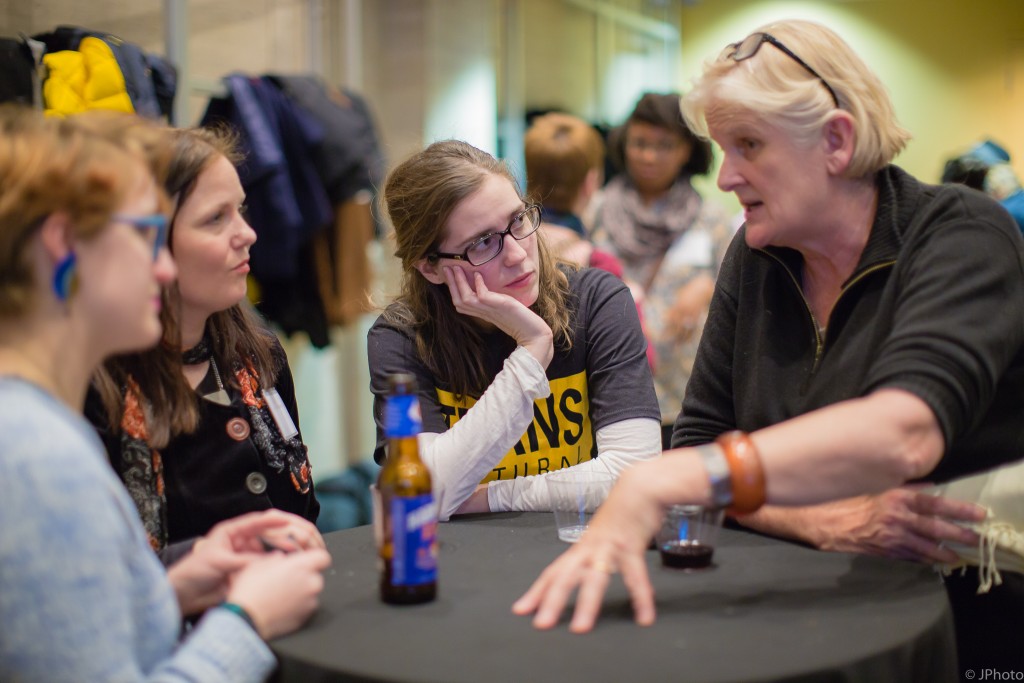
TransCultural Exchange 2016. Photo by Jie Yan.
10:00am. I'm eating a mini-croissant and looking at a hard copy of the schedule. With the exception of one volunteer, I'm the youngest person in the room. I'm not that young.
10:30am. I introduce myself to the woman sitting next to me in a small auditorium. She says she's glad to see a female presenter setting up on stage because when she checked in at registration, the line for attendees was composed entirely of women, but the speakers' line was all male. I mention that I've noticed that everyone I’ve seen since arriving was white. Then I realize it's an awkward thing for one white woman to say to another white woman, so I add “but I've only been here for a half an hour” and then for some reason, even though it's not funny at all, we both laugh.*
The speaker, Bojana Panevska, Program Manager at TransArtists in the Netherlands, is talking about how artists can research and find the perfect fit for them in terms of an artist residency program. But it's really a walkthrough of TransArtists' website/database, which I'm already familiar with. She does draw attention to a few very cool programs that I've never dug out of their system during any of my searches of it, and also answers audience questions based on her experiences on jury panels deciding who gets accepted to residencies. It's kind of shocking, though, that she doesn't really understand that Americans don't get local or national government support for traveling to be artists in residence.
12:15pm. I realize (too late) that lunch is BYO and the room for the “lunchtime roundtable discussion” on “Artist-Run Organizations” is too crammed full for me to try to slip out and back in again. Most of the time allotted is spent on everyone introducing themselves, but it turns out the leaders of the discussion are up to something really interesting to me. It's a description of the practice of a group of very subversive artists. I ask questions at the end, and want to go and talk to them a bit afterward, but they are rushed by a crowd that never really disperses until they have to leave to meet someone. Bonus points towards my goal though: another woman waiting to talk to them who runs a residency program in rural Sicily gives me her card. She's in Boston for a while, not just the conference. Note to self: go see her art show!
2:45pm. After a longer than anticipated four block walk against the wind, I'm at another session that's right up my alley: a presentation (billed as a workshop, but I'll be damned if it's not an artist's talk) called “Diary of Smells: Language, Sound and Olfactory Experience.” I ask tons of questions and run into B there, a local artist who I often cross paths with because we have overlapping interests... We talk a bit afterward and I ask her if she's come to the conference before. She says no, so I ask her how she was able to afford it. “I didn't pay my mortgage on my house this month so that I could attend this,” she answers. She also bought two portfolio reviews (at $35/each) and expects these to be the real value of attending. She wants feedback on how to get her work seen more. B is looking at the conference as an investment, and wants, right now, to improve her resume.
5:15pm. I run into a Brazilian artist, Carvalho, who presented at the workshop I last attended. She's excited to talk more about one of the questions I asked her in the “workshop” and maybe even to collaborate someday (!!) She asks for my card (!!) and then we walk against the wind together to the party across the street.
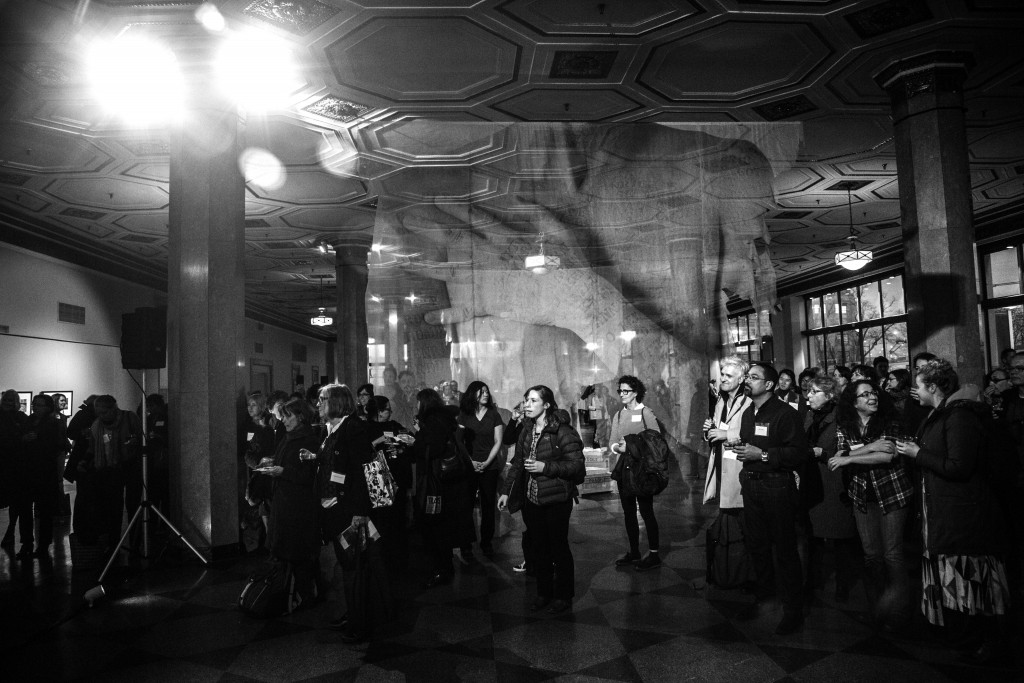
TransCultural Exchange 2016. Photo by Daryl Luk.
I'm starving, so I grab some crackers and cheese and start—out of habit really—to interview the people nearest to me. Both are from the West Coast, coming to the conference for the first time. I ask them if it was worth the travel. They both came in the hopes of meeting curators and haven't met any yet. “But it's only the first day....,” says the woman from Oregon. H, from California, says he's hoping to learn about science-focused residencies. They both feel so far that the conference content is better suited to emerging than mid-career artists.
6:30pm. Boston's “Art Czar,” Julie Burros, gives some warm and welcoming remarks at the opening reception. During the remarks, K comes over and gives me a hug. She's here from New York. I ask if she's speaking on one of the panels—she runs a project that evaluates artist residencies—so it would make sense. She says “No, but shouldn't I be?” She should be. So that now makes two people I know who have come to the conference and aren't panelists. Also, she's definitely younger than me.I forget to ask her how she paid for it, but it's probably a business-related expense.
February 26, 2016
10:30am. I'm torn between the workshop on elevator speeches (I'm terrible at talking about my artwork) and a panel about urban sound research. Sound research wins because I figure I can always read about elevator speeches online. I learn some very interesting history about sound in the context of urban planning in Boston, which is FASCINATING. But not necessarily what I came to the conference for.
12:30pm. Lunchtime roundtable discussion on water. H, from California, is here. He seems to have found his groove now—he's so busy networking that I can barely catch his eye. I also overhear people talking about how great the elevator speech workshop was.
1:15pm. I thought this panel would be about residency opportunities in Asia, Spain, Sweden and France, but the first two speakers are giving overviews of their federal- and municipal-level arts funding structures. At first, this seems useless to me, an American, but then it becomes maddening. How is it that France and Sweden support their artists and arts organizations as if they were real human beings undertaking fruitful endeavors?!
On the way out I run into D. It’s his second time in attendance. We discuss a theme that emerged from the panel—government changes in Asia and in Sweden impacting residency programs. He wonders why this gathering of people hadn't evolved over the years into a site where activism could begin to foment. I suggest he propose a panel or workshop for next time. I don't ask how he afforded to attend. He's a tenured professor, so I assume he gets funding to attend some conferences.
I noticed online that there was supposed to be some visual art at the conference, but I was unable to find it. D hadn't seen it either. I suggest that the conference invite local artists to fill the space with artwork as a way of de-institutionalizing the environment and gaining free access to the conference. D loves this idea. Note to self: Pitch art-trade-for-conference-pass idea to Transcultural Exchange and offer to jury it so that it's attuned in a way that amplifies the kinds of conversations being stimulated.
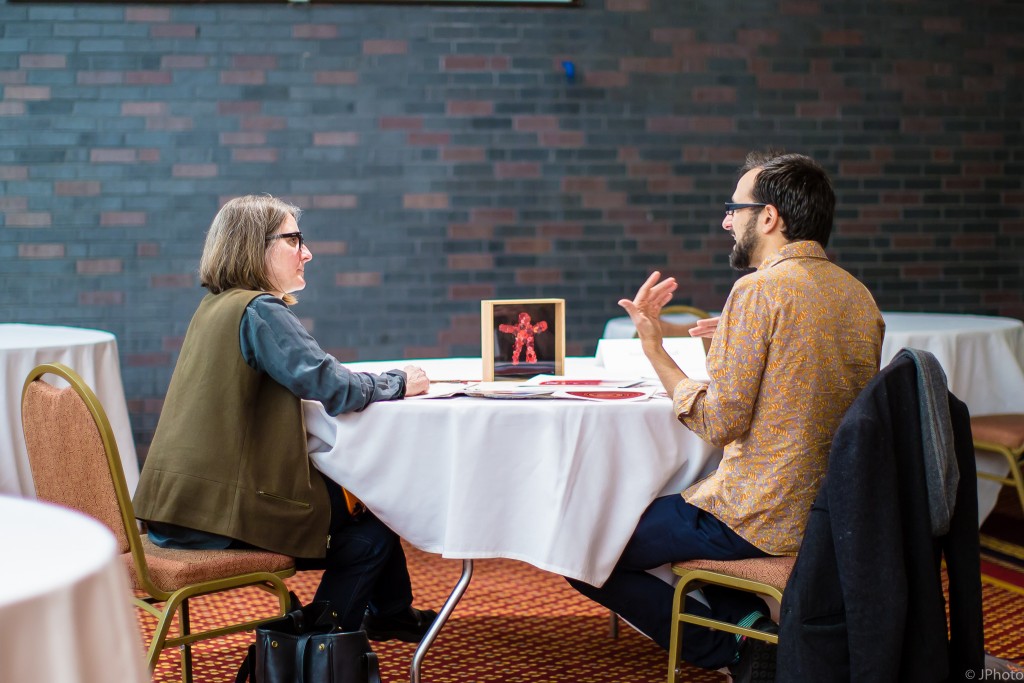
TransCultural Exchange 2016. Photo by Jie Yan.
4:25pm. “Far-Flung Residencies” gets political when someone points out that the “far flung” is no longer far-flung because war zones, often funded by the US, are creating an endless stream of refugees. There's an Egyptian artist speaking, Hamdy Reda, who runs a residency in his family home in an industrial neighborhood outside of Cairo. He is super smart, challenges the audience about why people feel the need to go elsewhere to do their artwork. He invites us to apply, but only after we've explored our own environments fully. I am charmed by him. I want to apply.
4:35pm. I stop a volunteer and ask her about her experience. She's enjoying herself—meeting really interesting people, learning a lot. Volunteering also allowed her a free portfolio review (!!) but she didn't get to choose whom it was withI ask her where the art is and she doesn't know but tells me about a conference-related performance by BU students.
5:45pm. My Transcultural Exchange conference experience is over abruptly! I'm not able to attend on Saturday. There's a “gala” but I don't have a ticket. The last conference thing happening today is at MIT but I can't get there before it ends at 6:30.
March 3, 2016
Looking back on my notes, though I found the environment un-artful, and the program guide (as well as the physical arrangement of the conference) sometimes confusing, I felt the beating heart of something “right for me” inside of it all. I could see through the problems with the conference to its intentions and they are right on—exposing artists to each other internationally, widening Boston's horizons, gathering intel on how things work, smell, and feel elsewhere. If I could change anything, it would be to refine the program guide and offer additional routes of entry to increase the diversity of who attends. How can this obvious boon to Boston's arts community draw more local artists in? Note to self: Help make the guides better. Help bring a wider audience in....
*Author's note: These first impressions on both our parts were unfounded: as the conference progressed, the speaker gender and racial balance proved, thankfully, to be more progressive.
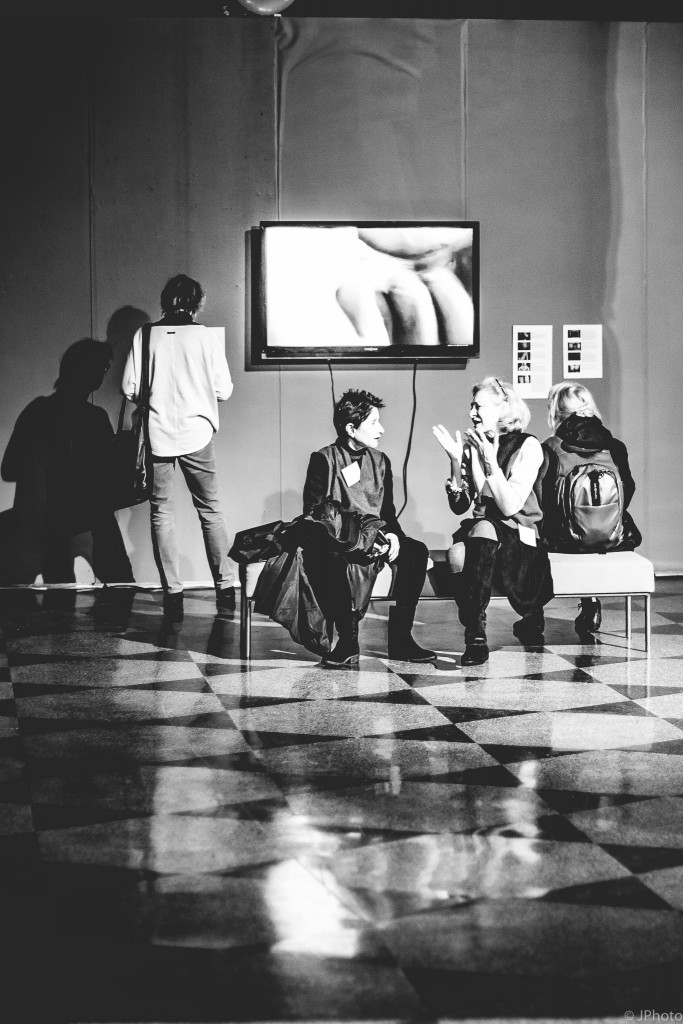
TransCultural Exchange 2016. Photo by Jie Yan.


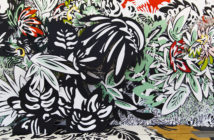


9 Comments
Dear Heather, Thank you so much for your thoughtful article!
One point: out of 170+ presenters: over 100 were women. As a women run organization, I’m very proud of this fact. (http://www.transculturalexchange.org/2016-conference/presenters.htm)
As for the artwork, there was an artwork by Rafael Lorenzo Hemmer – right in the lobby where registration was and next to the exhibitors’ hall … but anyway: sorry you missed it. Also 808 had an art show.. . ..
We don’t have more artwork, because – after having shows at the Conference, a fabulous piece by Florian Dombois’ last year (incuding shooting a laser across I90 last year and it barely receiving presshttp://www.transculturalexchange.org/activities/the-coaster-project/ although your publication did a fabulous write up!) and all of us exhausted by the red tape to do this – we decided we can’t manage a Conference and a lot of exhibits.
Please note though: that for over 25 years TransCultural Exchange has been doing global exhibits; and we actually have a project at UMass at the moment: http://transculturalexchange.org/activities/callerID/
Also, like the London Biennale we staged in Boston in 2010 (and the Conferences) ,we continue to attract more out of town artists to our projects and Conferences, although (aside from the last 2 Conference artworks) all our projects are free to apply to, open-call, announced on our website, social media, e-art, etc. I hope this will change and that your article will help us alert local artists of what we do.
In fact, I certainly hope your article encourages local artists to proposal panels to the Conference as well as attend. (Speakers receive a free pass – also to the dinner.) Again, I do not know why more local artists don’t do this. We write all the schools, advertise on e-art and Art & Education, etc. So, we certainly would appreciate help to change this. We are especially interested in attracting younger artists and really at $60 as the student registration, I don’t know why more students (younger artists) aren’t at the Conference. As for the $200+ price – it is by far the lowest such price for a Conference (especially of this scale) and barely covers 1/5th of the costs… .(also there are scholarships. . .)
‘hopefully your article will change things; and we will receive government or other support to make the Conferences free, etc… . here’s hoping! Many thanks again for letting people know of the Conference, Mary
PS. I feel quite bad not to mention before: along with Rafael Lozano-Hemmer’s ‘Level of Confidence” (sorry: for his name’s misspelling above), the Conference’s closing ceremony at Emerson, included the unveiling of a new public art work by Mischa Kuball’s ‘Para” . Misha also gave a great talk at the Conference earlier that day, the 25th.
(Joe Ketner at Emerson arranged Mischa’s project, which I’m thankful for; afterwards TransCultural Exchange also organized a free concert – open to the public – of new music at the Goethe Institut and nonevent.) Thank you again for your article. The Conference is a huge effort and we’d be so happy if more local artists took advantage of it.
I also attended the TransCultural Exchange conference, which I really enjoyed. On the panel that I moderated – which was about art and disability with a focus on blindness – we had great touchable sculptures by David Johnson on display. After the panel presentation, the audience had the opportunity to explore David’s works followed by a wonderful discussion. It feels like the author of the article above went only to half of the events of the conference and missed out on many wonderful opportunities.
I have attended these conferences over the years, international art projects my thing to do so I go. Each conference has been progressively disjointed and more of a feeling “us and them.” This year being my least favorite, it only follows suit they haven’t even sent a feedback query out.
I cut out of a number of sessions this time because the A/V was intolerable or the subject wasn’t what I’d hoped. Sometimes the session I went to didn’t happen. The sessions I would have loved to attend were filled up and closed before I knew they existed, despite having been an early registrant.
I notice over the years, the tone has changed. It’s for the academic, less for the artist trying to shop residencies. If it could go back to the way it was the first couple of times, I’d go again.
Please check you spam folder and email. A survey was automatically sent out over a week ago from survey monkey to everyone who registered. Perhaps – similarly – you missed the email from eventbrite that told you about the sessions to sign up for – which was automatically sent by eventbrite when you registered. (As only the mentoring sessions and 5 tours had limited participation, I’d also be curious to hear what event was closed to you; so we would know which things we should try to make available to more people.)
In general, I’m really surprised by your response; as the survey responses we have received have been overwhelmingly positive – with well over 90% claiming that the Conference was not only great; but that it was the best Conference yet. Like always, we will publicly post these – and all – comments online. (For instance, please see http://www.transculturalexchange.org/2016-conference/survey.htm.) By the end of the summer, we hope to have this year’s Conference’s comments online as well; and of course, if you would like yours to be included, either please fill out the survey or email TransCultural Exchange as we also include all the comments we receive by post or email in these reports.) We would also , of course, be interested to know where the A/V was intolerable (as your reply is the first time I’ve heard this) and which subjects you would’ve like to have heard.
I am sorry, though, that you dislike that we have introduced topics into the Conference; but through past surveys and focus group responses, most attendees highly appreciate these; and, thus, we would be remiss not to continue along this path. Further, I am surprised to hear that the Conference is less useful for you in terms of shopping for residencies than in the past as the number of residencies represented at this Conference was greater than any in the past and more than 4xs what they were at the first Conference.
I also hope that you did notice that we introduced dozens of round-table discussions to promote even more interaction between attendees and speakers on an equal level – as everyone was able to speak in these, being that they were discussions – not papers. I also know of no speaker unwilling to speak to anyone. And, again, this seems very counter to the other responses we have received.
If you would like, of course, you are also welcomed – like anyone else – to propose a panel or round-table discussion through our open call. I can understand, though, if this greater mix of activities is something may not be to your liking. Of course, we can not please everyone; but to be viable, we need to be sensitive to the majority of the feedback we receive. Thank you for attending in the past.
Mary,
Thank you for your reply. I checked harder and did find a response form in the email. Thank you. But no, definitely no notices on when new events were added to the schedule after I had signed up. That was lost opportunity to me. The only reason I paid all that money to attend.
I would have had to check back on the web site frequently to have noticed when pages and data were loaded.
I want to let you know how I feel and others I have met shared they felt with me about the us and them sense of this conference, because you can correct this. I still love the topic and as long as I live will have ties to other countries art worlds, I very much wish you the best.
This was my first time at the conference, and I was really impressed by the scope and richness of the experience brought together by the collision of so many very different and intelligent participants!
Some included artists Florian Dombois, Josephine Turalba, Ingo Vetter, and curator Iola Lenzi. I was able to interview the legendary Benoit Maubrey, and have made warm contacts with several young artists in the US and Europe. I also ran into someone who had recently interviewed me for a PhD in person, which was great and helpful for both of us. It was a true privilege to meet and speak to so many established artists.
The conference already had, and will continue to have, a great impact on me both in terms of the contacts I made but also simply in terms of new ideas, ways of making, and kinds of thinking that were opened up to me there. No conference can encompass everything, but over the three days I felt stuffed full of interesting knowledge, images, opinions, and ideas — thank you!
The tone of this article is cavalier and self-indulgent. This can be fun, but in the context of reviewing a major conference on the arts it is careless. Careless of the integrity of “Big, Red and Shiny”. Careless of the conference itself. And careless of the artists it purports to address. Anyone who attended the entire conference. Anyone who read the entire schedule of events. Anyone who had asked for directions. Anyone who listened to one, let alone both, of the featured speakers. Anyone who really participated in the conference would know that the conference was an extraordinary success. To insinuate otherwise is a disservice to Boston and its arts community.
Thaddeus, I came back here to reply an earlier post, but I must ask you to check yourself.
You’re one of the people who took part in the event. You’re privileged. For years (yes, you know me and I’ll identify myself next time we sit together at a symposium or something or other as we sometimes do) I have gone as a mere consumer of this programming. I have a different take on it, and I’ve heard many others from that frame express the same. There is an “us and them” difference of experience, unfortunately.
I stopped calling it a success at this point. It’s disjointed as a conference. It’s disorganized, it’s not fun to wander between ends of town and building to building only to find the discussion may not exist. I go to other types of conferences in other fields, in other countries and here. This one has perhaps too ambitious a scope. You can still call it what you want, and we can, as the writer above can, each have a valid experience. If you want a seasoned conference attendee’s view, it would be more scathing than anything BR&S published.
You sat next to me a few times in the second conference back from this last one, btw.
Take care, babe.